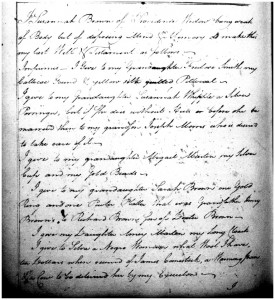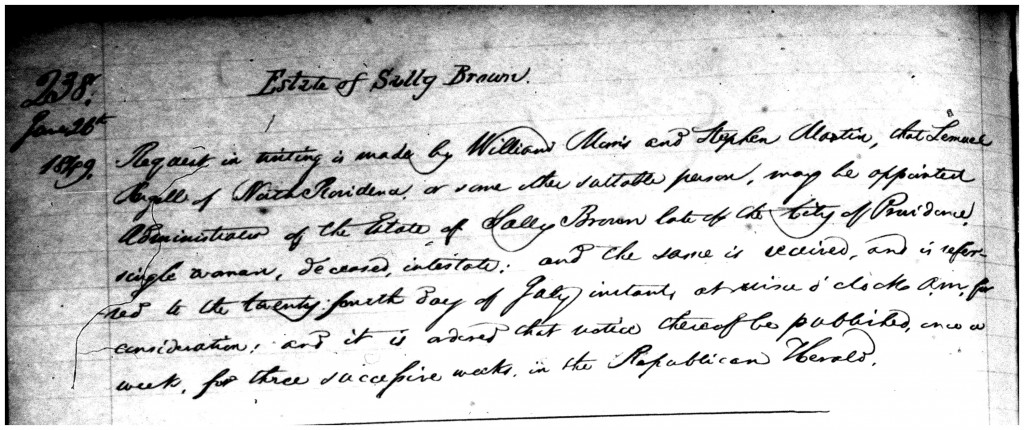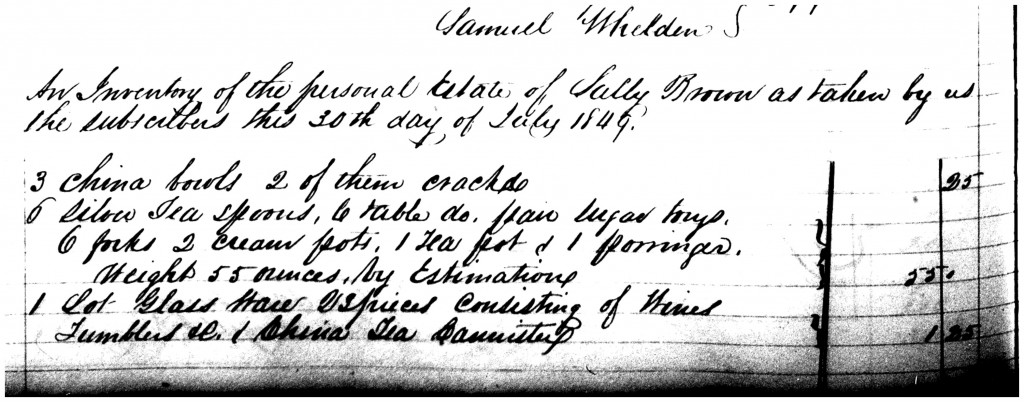
Recently, I had a client who wanted to know more about a silver teapot designed by the Hurd silversmiths of Boston that had been passed down through his family. The teapot had the name “Sally Brown” engraved on it, but to his knowledge, he did not have any Brown relatives, which made the teapot a bit of a mystery.
With some research, we found a connection to the Brown family through ancestor Amey Martin (1784–1852), the wife of Samuel Nightingale Richmond; her parents were Silvanus Martin (1748–1819) and Amey Brown (1749–1833) of Providence, Rhode Island. Though I located a connection to a Brown family, my client’s direct ancestry did not contain anyone named Sarah or Sally Brown.
The parents of Amey Brown were William Brown and Susannah Dexter. I searched our microfilmed collection of Probate Records of Providence, Rhode Island, 1646-1899, for an estate for either individual that might mention a silver teapot. The will and inventory of William Brown were filed in Providence in 1782. In his will, William Brown mentions his wife, Susannah Brown, as well as his children, Dexter and Amey Brown. The inventory for William Brown lists several tea kettles and teapots, but does not leave a particular teapot to Amey (Brown) Martin. However, since William Brown does not mention a daughter named Sally or Sarah, it was difficult to determine whether any of these teapots could be the “Sally Brown” teapot.
The will of Susannah (Dexter) Brown proved to be very interesting. In addition to notice of silver cups and spoons, to be given to her children and grandchildren, Susannah mentions a granddaughter named Sarah Brown. As she is the only grandchild with the surname Brown, that would make Sarah Brown the daughter of Dexter Brown, the brother of Amey (Brown) Martin.
With a potential owner of the silver teapot now identified, I searched Providence resources in an attempt to learn more about Dexter Brown and his daughter, Sarah. In Historic and Architectural Resources of the East Side, Providence, which includes summaries of historic homes of Providence and their inhabitants, I located an entry pertaining to Dexter Brown. Following his marriage in 1769, Dexter Brown built a large house in Providence, which passed to his daughter Sarah Brown (1771–1849) upon his death. According to the report, the land that Sarah Brown inherited from her father was later referred to as the Sally Brown Farm. There is no mention of Sarah (“Sally”) Brown ever marrying or having children.

Sarah Brown did not leave a will in the Providence Probate Records. However, an administration was filed for Sally Brown in 1849; according to the record, Sally Brown, single woman, died 14 July 1849. There are two administrators of Sally’s estate: William Morris and Stephen Martin. Stephen Martin is the brother of Amey (Martin) Richmond and a cousin of Sarah “Sally” Brown. In the inventory of Sally’s estate, she is listed as having a silver tea set, including a silver teapot.

Given the information found in the probate records, it seems very likely that Amey (Martin) Richmond inherited the teapot upon Sally’s death in 1849. Since Sarah “Sally” Brown was unmarried at the time of her death, her estate would have been divided up amongst her living relatives. Based on what we know about Sally, it does not appear that she had any living siblings at the time of her death. The fact that Sally inherited her father’s farm when he died in 1810 means that she was likely Dexter Brown’s only surviving heir, as the land was not passed to a son. Therefore, if Sally did not have any siblings, her estate would have been divided and inherited by her cousins, including Amey (Martin) Richmond.
Wills and administrations often provide invaluable information when making family connections, and other probate records, such as inventories, can prove extremely helpful when looking at family heirlooms or looking into the day-to-day lives of your ancestors.
Are any of the microfilm records available via Internet? When you write microfilm records does that mean we must go to the Society to access?
Well done on the Saga of the Sally Brown Teapot
I have an ancestor, James Prichard, who is mentioned as a Silversmith. He was reportedly from London, born about 1750, lived in Dutchess County, NY during the Revolutionary War and died in 1816.. He is on a list of silversmiths that I once found. Does anyone have some great ideas on how to locate an ancestor by his profession? Nothing the Prichard will mentions his occupation or specific gifts. How nice to know the story of a teapot!
It reminds me of my Sally Johnson Beach mystery. I found her in a baptism record for one of my ancestors, but there wasn’t any Johnson in the family tree. Since she was baptised as an adult, I didn’t know if Johnson was a middle name or a married name. I eventually found land records for her mother’s father and her maternal grandmother’s father. Both of them sold land to a Johnson family. One was the father of a Sally Johnson and the other was her grandfather. Maybe someday I will find that the Johnson family married a sibling or cousin of one of Sally Johnson Beach’s ancestors.